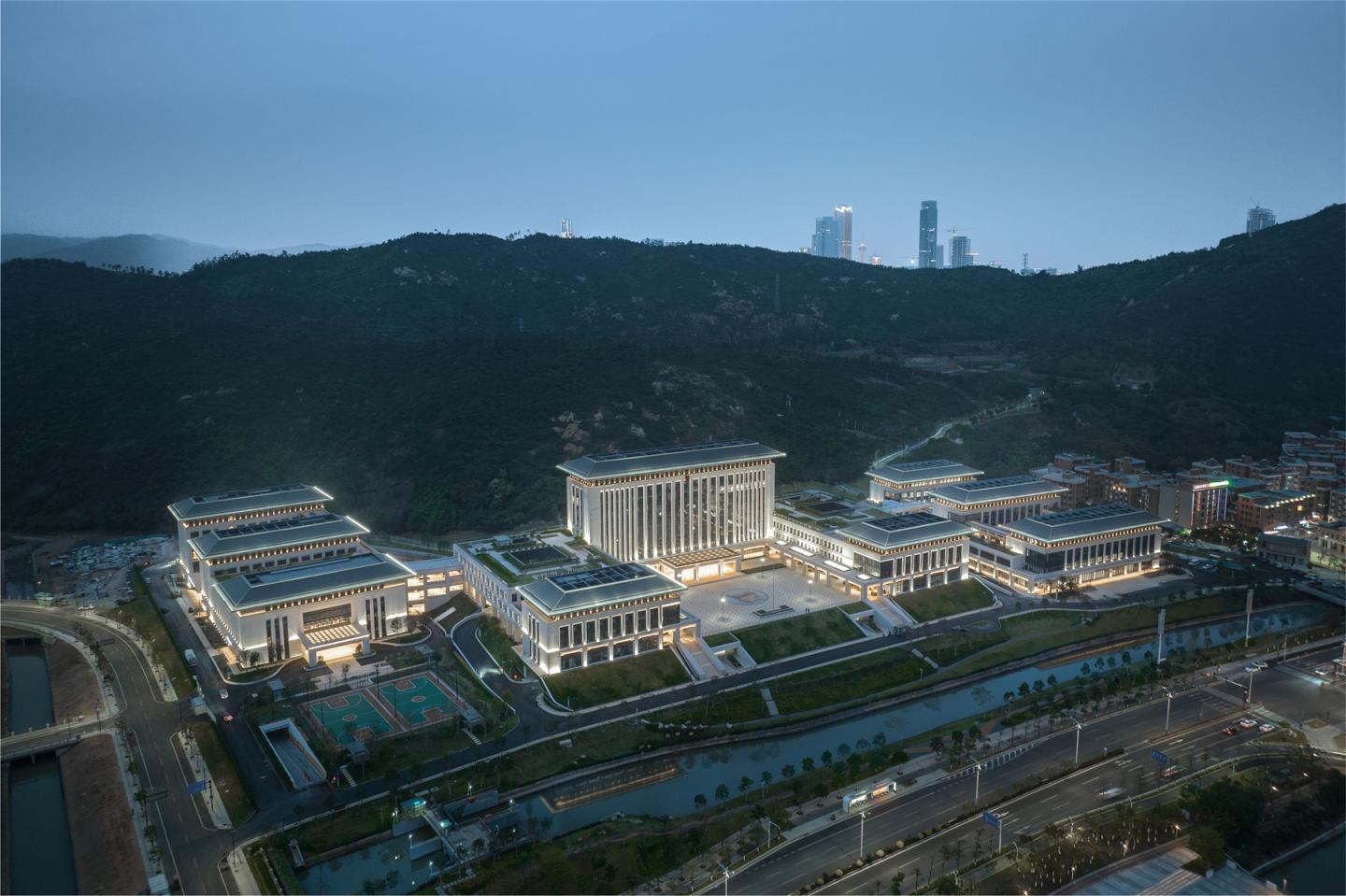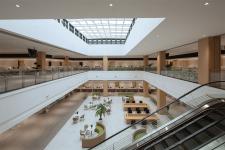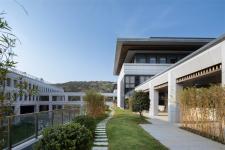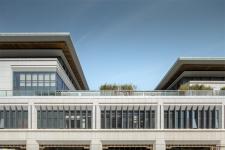As one of Zhuhai’s major livelihoods projects, the Hengqin New Area Civic Center will become a public building landmark of the Hengqin New Area, as well as a frontier for government services, economic reform and innovation in the Guangdong-Macao In-depth Cooperation Zone in Hengqin. The project integrates administrative offices, public services and leisure center, as an important public facility to provide government services to enterprises and residents in Zhuhai and Macao. The project covers an area of 65,530 square meters and a building area of 131,876 square meters, with the main programs including administrative service center, civic center, conference center, reception center, etc.
The site has the dual advantages of a favorable geographical location and a unique natural landscape of Lingnan. It is bordered by the Little Hengqin Mountain in the north and the urban green area in the south, and is located on a green axis of urban development that integrates the natural and cultural landscapes of the city. Meanwhile, there is an urban water system parallel to Hong Kong-Macao Boulevard to the south of the site. The mountainous terrain of varying heights, combined with the water system, fully embodies the urban natural landscape of the Lingnan region. Therefore, one of the focuses of the project design is to combine the topography of the site as well as the natural environment of the surrounding mountains and waters to form an architectural cluster with local characteristics.
Another focus of the design is to deal with the site's spatial relationship with surrounding urban functions. The west side of the site is zoned for administrative offices such as procuratorate and court, the east side is for village construction, and the southeast side is planned to be a large residential area. In addition to giving full consideration to presenting the overall image of the core of Hengqin New Area, the project should reflect the public and open nature of the Civic Service Center, and strengthen the coordination of urban functions with surrounding constructed and planned buildings. It aims to better utilize the site conditions rationally and create a new type of multi-functional activity area for urban residents.
Design Concept
The project responds to the ecological and geographical attributes of the site with the design concept of "landscape city, ecological island". Building on the existing and unique scenery, the Hengqin landscape culture is integrated into the architectural design. Drawing inspiration from Zhuhai's traditional housing blocks, the layout of the building volumes conforms to the mountains and the river, shaping a beautiful organic building cluster and interesting street space.
The overall planning structure emphasizes the relationship between the architectural axis and the opposite view, with the main building facing the main axis of the cityscape. Meanwhile, a ribbon landscape corridor, while corresponding to the existing water system and the mountains, divide the site into two parts: architectural clusters, and the public park space. The core building cluster - the Administrative Office Center - is located on the north-south cityscape axis, while the other two building clusters are on the left and right to achieve balance. Following the mountain terrain, the height of the building clusters decreases from 18 meters from north to south, generally presenting a north-high-south-low terrain, with gradual access to the civic activity areas such as pedestrian plazas through a system of staircases and ramps.
Functional Layout
The design of the building clusters respects the original topography and adopts a low-impact building development mode. The layout of the buildings is centralized to avoid excessive damage to the original terrain and to reduce the volume of buildings on the ground. Buildings are divided into three clusters, and the internal spatial arrangement of the clusters adopts the model of "three rooms and two corridors", which is the most characteristic layout of Lingnan houses. Each cluster is surrounded by courtyards and connected by corridors between the north and south, providing ventilation and lighting, in a green and energy-saving manner. The form of "three rooms and two corridors" is taken as the planning theme and the enclosed courtyard space to echo traditional Lingnan history and culture.
In terms of building functions, the three building clusters from east to west mainly include the following functions:
The Administrative Service Center is a five-story building. Its first and second floors are administrative halls with 200 counters, in which municipal services and corporate services are organized into two atriums. A section of continuous colonnades is planned on one side of the ground floor, reflecting the design elements of the traditional Lingnan arcades.
The Administrative Office Center, as the tallest building within the site, has a nine-story tower. The podium on both sides of the tower has four floors. There are 15 government offices, with functions including office, reception, meeting, archives and so on. The formal elements are drawn from traditional Lingnan architecture, such as "cold lanes", "arcades", "corridors", and the eaves of local houses are adopted. Among them, the design of the corridor can take away the hot air in the building and form a good air circulation. The interior is divided into separate zones without interfering with each other, and the design of public space is emphasized, with the resting area, green roof and foyer set up as shared space, and the first floor of the building is partially elevated to provide public grey space.
The Conference Center has six floors. It is equipped with sports facilities and reception center, as the supporting functions of the whole complex.
The three building clusters are closely and efficiently connected by a system of pedestrian corridors, thus forming a complex and coherent entity. The project is different from traditional governmental offices, realizing the three-in-one of office service, culture and recreation, and urban park, and integrating urban functions such as conference reception, cultural center, sports center, public square, etc. to create a one-stop service center with a high degree of accessibility and openness.
The plants of the southeast coastal region are seamlessly embedded in the building, creating a comfortable environment where man and nature mingle. The courtyards and roofs of the buildings are designed as green spaces. Roofs are designed as green courtyards, planted with highly ornamental trees and flowers, and the roof gardens provide a comfortable and pleasant relaxation space for office workers.
The public space part of the urban park is mainly located in the south side of the site, creating public open spaces with the theme of Hengqin landscape, by combining with the water system to form a large landscape plaza for public activities. The buildings are arranged facing the landscape square, which is equipped with diversified landscape nodes such as sports park, internal courtyard, sunken courtyard, etc., forming a hierarchical and staggered landscaping and greening system.
Architectural Style and Materials
In the details of the façade, we have made a modern interpretation of the façade decoration of traditional Lingnan houses. By refining and simplifying the colonnade, the first floor eaves, and the colors of the typical historical buildings, a modern and simple façade with a traditional flavor emerges.
The pattern design of the exterior sunshade shutters draws from the window panes of traditional Lingnan architecture, absorbing the characteristics of regional maritime culture, and the patterns are taken from the traditional wooden lattice windows, as well as the Manchurian windows that appeared under the influence of Western culture.
The façade is made of white stone, with dark gray contours dividing it into concise vertical sections, highlighting the outline of the panels and enriching the façade design.
We studied and refined the details of the eaves of traditional Lingnan houses, the density of the rows of roof purlins and the distribution between the tiles, and used copper panels to strengthen the visual impact of the Lingnan elements, creating an echo of the tiles and ridges. We also abstracted the decorative details under the eaves of local buildings, and designed the details under the eaves by using light grey aluminum panels and decorative copper panels. The eave detailing is designed with multiple layers and metal lattice to reflect its cultural characteristics.
Sustainable Design
The project promotes the design concept of green ecology, energy saving and environmental protection, following the idea of sponge city and the implantation of green building technology. With reasonable consideration of the site topography, the proportion of impervious surfaces is reduced, and rainwater runoff is naturally guided into ecological rainwater management facilities for water recycling. Meanwhile, during the whole life cycle of the building, it focuses on low consumption, high efficiency, economization, environmental protection, integration and optimization to maximize resource conservation, such as the implementation of water-saving devices and intelligent energy-saving systems, in order to provide people with healthy, comfortable and efficient space to use.
2018
2022
Project Location: Hengqin Island, Zhuhai City, Guangdong Province, China
Site Area: 65530.76 ㎡
Total Floor Area: 131876.41 ㎡
General Design Contractor: Shanghai HuaDu Architecture & Urban Design Co., Ltd. (HDD)
Master designer: SHEN Yi, DONG Weiwei
Project leader: AN Hao, DONG Weiwei
Chief Architect Designer: ZHU Qixiang, DONG Weiwei
General Design Contractor Team
Architectural Design: SHI Feng, YANG Tao, ZHENG Xueyi, XU Jing, CHEN Lei, SUN Tongtong, LI Su, Luca Forteleoni, Ebenezer Osei Asante, YAO Endi, LENG Changzong, GONG Benling, CHEN Xiaotong, CHEN Jianfei
Construction Design: SHI Feng, YANG Tao, LIU Jun, SHAN Chao, ZHOU Zhaomin, ZHOU Jun, CAI Baiyang, FENG Xiaolong, CHI Hengdong
Structural Design: ZHANG Yongqiang, ZHOU Zhen, XU Bingbing, WANG Kun, WANG Guoxun, XUE Hao
Water Supply and Drainage Design: JIANG Yi, WU Wenwen, WANG Yikun, LIU Miaomiao, YU Xinguang, ZHAI Ziman
Electrical Design: REN Fusheng, XIAO Yan, CAO Yuhao, CHEN Yu, ZHANG Yi, ZHU Xudong, YUAN Jiangfeng, WAN Danqi
HVAC Design: DONG Yunfeng, QIAO Xueliang, XUE Xiaofeng, GUO Xinxia, LIU Jiakang, REN Yi
Landscape Design: ZHU Yiyu, WANG Dandan, YANG Gang, FEI Yidong
Interior Design: GE Qing, AI Jingwen, LIU Haitao
Project Estimation: YANG Qinglin, ZHUANG Qin
Co-Design Unit
Interior Design: YASHA Decoration Co., Ltd
Curtain Wall Design: BURO HAPPOLD
Landscape Design: Guangzhou Landscape Architecture Design & Research Institute Co., Ltd.
Floodlight Design: Shenzhen Sunmemory Lighting Technology Co., Ltd
Logo Design: Shenzhen Wedo Sign Co., Ltd
Consulting Unit
Transportation Consultant: MVA Transport Consultants (Shenzhen) Co Ltd
Mechanical and Electrical Consultant: WSP
Green Building Consultant: Shuifa Energy Engineering Technology (Zhuhai) Co., Ltd
Acoustic Consultant: Shanghai Ginpulse Acoustic Engineering Technology Co., Ltd
Kitchen Consultant: Nod Kitchen Planner Co, Ltd.
Art Consultant: Auchan Space Art Consultant (HK), Shenzhen Norder Soft Decoration Engineering Co.Ltd
Photographer: TANG Xuguo










